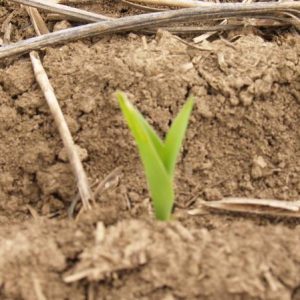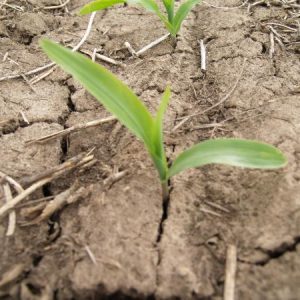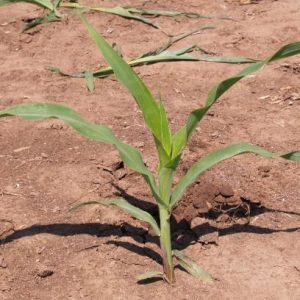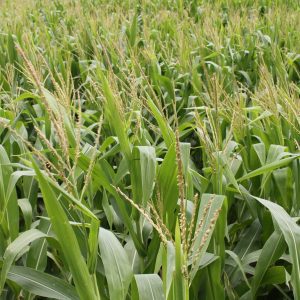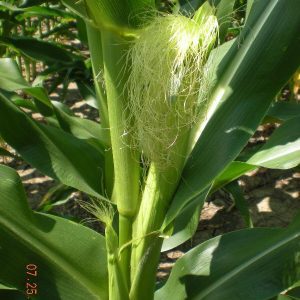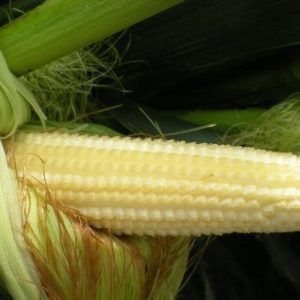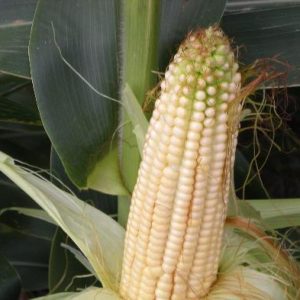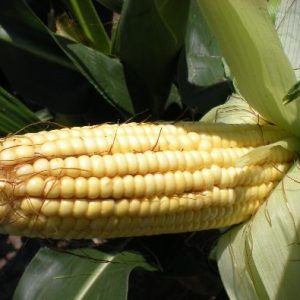Crop Production

Corn plants develop through growth stages that are well defined and easy to identify. Crop managers can adjust some environmental conditions to increase yield. Knowing how a corn plant develops is crucial to promoting and applying management practices in the field to make a crop more sustainable and profitable.
Plant growth is divided into vegetative and reproductive stages, each with morphological characteristics and physiological processes. Corn growth and development are measured by the amount of dry weight accumulation in the plant that happens through photosynthesis, a physiological process in which plants manufacture carbohydrates, proteins, and oils, and which is directly related to environmental conditions. Thus, corn growth and yield are the result of interactions between genetics and the environment during the plant life cycle.
Farmers can manage some environmental factors to maximize yield, such as seeding at the right time, using adequate plant density, fertilizing the soil, and optimizing weed, insect, and disease control. Other factors, such as air temperature and solar radiation, cannot be controlled but do affect the way plants develop. Understanding how corn plants grow helps producers identify management practices to obtain higher yields.
Corn plant development is divided into vegetative (V) and reproductive (R) stages as shown in table 1. Vegetative emergence (VE) occurs when the coleoptile, or spike, emerges through the soil, and the vegetative stages are numbered V1 through Vn, where n is the number of leaves with visible leaf collar until the tassel emerges (VT). The collar is the point where the leaf blade visually separates from the sheath and the stalk of the plant, and V stages refer to the number of visible leaf collars. Each V or R stage is defined only when 50 percent or more of the plants in the field are in or beyond that stage.
Table 1. Vegetative and Reproductive Stages of a Corn Plant
| Vegetative Stages | Reproductive Stages |
|---|---|
| VE Emergence | R1 Silking |
V1 First leaf | R2 Blister |
| V2 Second leaf | R3 Milk |
V4 Fourth leaf | R4 Dough |
| V6 Sixth leaf | R5 Dent |
V(n) Nth leaf | R6 Physiological maturity |
| VT Tasseling |
See table 2 for more detailed information on corn growth stages and management practices.
Table 2. Corn Growth Stages and Management Practices
| Stage | Title | Description | Management Practices |
|---|---|---|---|
| VE | Germination and emergence | Coleoptile is above the soil surface, but no collar leaf is visible. Nodal root system is initiated, and radicle is present. Low temperatures may slow the emergence process. | Check stand and uniformity. If stand is poor, replanting may be needed. |
| V1 | First leaf | First leaf with collar visible (round tip). From this point forward, growth stages are defined by the uppermost leaf with visible collars until VT. | Scout for early-season insects, diseases, and weeds. Check initial population for proper emergence. |
| V2 | Second leaf | Second leaf with collar visible (pointed tip). Nodal roots emerge underground, while seminal root growth declines. | Scout for early-season insects, diseases, and weeds. Apply postemergence herbicides if needed. |
| V4 | Fourth leaf | Fourth leaf with collar visible. Leaves laid alternately in succession (side by side). Growing point is below the surface until V5. Nodal roots are exploring the soil for nutrients. Cold soil temperatures may delay growth, increase the total number of leaves, and delay tassel formation. | Control weeds to reduce competition. Scout for insects and diseases. Soil nutrient availability is critical. |
| V6 | Sixth leaf | Sixth leaf with collar visible. Growing point and tassel are above the soil surface. Stalk begins a greatly increased elongation period. | Watch for visual nutrient deficiencies and treat accordingly. Side dress using N if needed. Scout for insects and diseases. |
| V8 to V10 | Eighth leaf to tenth leaf | Eighth/tenth leaf with collar visible. Plant is growing rapidly, with new leaves appearing every 2 to 3 days. Demand for water and nutrients is substantially high to maintain growth rate. Stress from pests, heat, lack of nutrients, and water can slow development. | Continue watching for nutrient deficiencies. Scout for root-lodging issues and diseases (such as common rust, brown spot). Monitor soil moisture, and start irrigation accordingly. |
| V12 forward | Twelfth leaf to more | Twelfth leaf with collar visible. Leaves continue to develop, and final number will be approximately 20. The potential number of kernels per ear and ear size are determined at V12. | Continue monitoring soil water availability, and start irrigation as needed. Scout for insects and diseases. |
| VT | Tasseling | Last branch of the tassel is visible at the top of the plant. Silks are not visible. Pollen shed begins and will last 1 to 2 weeks. Hail events can severely damage yield. | Scout for insects and diseases. Nutrient and water (0.3 inch per day) demands for the crop are close to maximum; apply as needed. |
| R1 | Silking | Silks are visible outside the husks. Pollen shed typically occurs during early or mid- morning. Pollen captured by silks fertilizes ovules within 24 hours. Heat and drought will affect pollination and final yield. | Scout for insects that damage silks through feeding (rootworms). |
| R2 | Kernel blister | Kernels are whitish and shaped like blisters. Moisture content is about 85 percent. Silks turn brown and dry rapidly. Any severe stress can result in aborted kernels and reduce their number on the cob. R2 occurs approximately 10 to 14 days after silking. | Irrigate as needed, as irrigation is critical at this point. Scout for insects and diseases. |
| R3 | Kernel milk | Kernels are mostly yellow on the outside, contain a milky white fluid inside, and have a moisture content of about 80 percent. R3 occurs approximately 18 to 22 days after silking. | Stress may still damage final yield. |
| R4 | Kernel dough | Kernels are filled with starch, have a dough-like consistency inside, begin to dent on the top, and have a moisture content of about 70 percent. R4 occurs approximately 24 to 28 days after silking. | Stress may still damage final yield. |
| R5 | Kernel dent | Almost all kernel crowns are denting, and a distinct horizonal line (milk line) can be seen between the yellow (starchy- solid) and white (milky-liquid) areas on the kernel. Moisture content is about 55 percent. R5 occurs approximately 35 to 42 days after silking. | Stress may still damage final yield, particularly by reducing kernel weight. |
| R6 | Physiological maturity | The starch line is at the kernel tip, and a black layer is formed at the base of the mature kernels. Kernel dry weight reaches its maximum, and moisture content is about 35 percent. R6 occurs approximately 55 to 65 days after silking. | Severe stress after this stage no longer affects yield unless the integrity of the stalk is compromised by disease or windstorm. Harvest can proceed after this point, but grain is not ready for safe storage. |
The vegetative and reproductive stages comprise the development of an individual plant; however, determining the specific stage of an entire cornfield requires that at least 50 percent of all the plants be at that stage or beyond. To adequately and accurately determine the average stage of development, collect plants from different places in the field, including at least one 10-plant sample for every 10 acres. Select plants randomly at each inspection site, but avoid selecting only the largest or most vigorous ones. To ensure random selection of plants within a row, try to evaluate consecutive plants that have an undamaged main stalk.
Appropriately and accurately identifying growth stages helps guarantee that those involved in corn production use the same terminology when discussing corn development, thus reducing the risk of damaging a field with a poor management practice decision. If, for example, herbicide treatment is recommended before corn reaches the V4 stage or if a fertilizer application at the right time provides a greater response, identifying which leaves are included to properly identify the stage makes for a more informed decision.
Reference
Ritchie, S. W., Hanway, J. J., Benson, G.O., and Herman, J. C. How a corn plant develops. 1993. Special Report 48.
- Figure 1. Germination and emergence (VE)
- Figure 2. First leaf (V1)
- Figure 3. Sixth leaf (V6)
- Figure 4. Tasseling (VT)
- Figure 5. Silking (R1)
- Figure 6. Kernel blister (R2)
- Figure 7. Kernel milk (R3)
- Figure 8. Kernel dough (R4)
 Eros Francisco, Extension Specialist, Assistant Professor, Crop, Soil, and Environmental Sciences, Auburn University.
Eros Francisco, Extension Specialist, Assistant Professor, Crop, Soil, and Environmental Sciences, Auburn University.
New February 2022, How a Corn Plant Develops, ANR-2863


